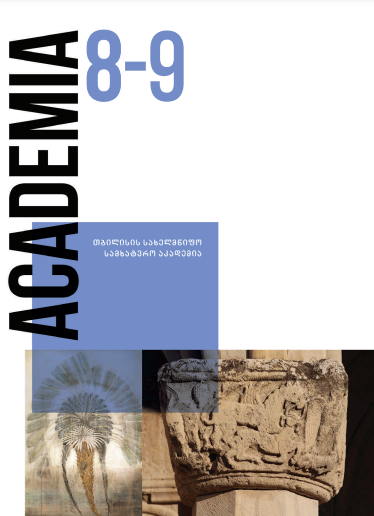Importance of Research into the Gaji-Plaster for the Wall Painting Technology
Main Article Content
Abstract
Adequate understanding of plaster supports of the wall paintings is of essential importance for their conservation. While it is commonly convenient to categorise plasters according to their binders such as lime, gypsum, or earth, these groupings contain extraordinary heterogeneity. One example of a complex plaster material is Gaji - a term used in Georgia for plaster that contains substantial proportions of both gypsum and clay minerals, which are present naturally in the quarried rock. Similar materials have been used in Central Asia, Middle East and across the Caucasus under various names, such as Gunch, Gaaj, etc. Uses of such material as plaster support for wall painting technology can be traced since medieval period in Georgia, in particular in David Gareja Monastery complex and in 19-20th century residential and religious buildings. The historic and current use of Gaji plasters across Georgia means there is a pressing need to better understand the material and in particular to address urgent conservation needs of wall paintings on Gaji plasters. The absence of understanding of original plaster technology and conservation methodology for Gaji plasters was brought into sharp relief by the discovery of the wall paintings of the Church of St. Demetrios of Thessaloniki in 2015. This prompted the authors of the article to start a pioneering international collaborative research project concerning Gaji plaster. Unfortunately, the project was significantly curtailed by the effects of the Covid-19 pandemic. This paper draws upon early investigations within that project as well as the conservation project of the Church of St. Demetrios of Thessaloniki. In discussing the project at this stage, the scholars hope to outline the urgent need for further research into Gaji plasters and compatible conservation materials.
The composition of historic Gaji and commercially produced Gaji in Georgia was investigated as part of an effort to develop compatible conservation materials. It was found that generally newly produced Gaji is gypsum rich and poor in clay minerals, while composition of historic Gaji showed higher concentration of clay and lower concentration of gypsum. An interesting finding was presence of charcoal inclusions in original Gaji plaster, which can be linked to the Gaji firing process or use of it as an additive. A more detailed comparison of modern and historic Gaji materials and construction methods in Georgia will be the subject of the further research.
